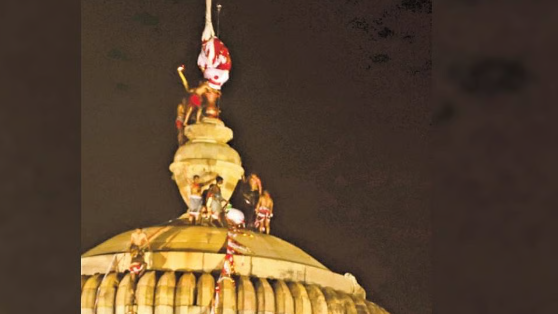

Bhubaneswar: Working as a servitor in Odisha's magnificent temples requires not only devotion and skill but also a deep understanding of safety protocols. The towering spires of temples like Lingaraj, Jagannath, and countless others across the state present unique challenges for maintenance and ritual activities that take place at dangerous heights.
Expert servitor Mahabir Das, with decades of experience scaling temple tops across Odisha, emphasizes that preventing accidents requires careful preparation, proper techniques, and unwavering attention to safety protocols. His insights have helped numerous servitors avoid potentially fatal incidents while maintaining these architectural marvels.
Odisha's ancient temples, particularly the iconic Lingaraj Temple in Bhubaneswar, feature complex architectural elements that create specific safety challenges. The weather-worn stone surfaces, intricate carvings, and steep angles of the temple spires demand specialized knowledge and extreme caution.
"Every temple has its own personality and dangers," explains Mahabir. "The stone becomes slippery during monsoons, and centuries of wear have created weak points that servitors must identify and avoid." Understanding these architectural nuances forms the foundation of safe temple climbing practices.
Before ascending any temple structure, Mahabir advocates for thorough safety assessments. This includes examining weather conditions, inspecting climbing routes, and evaluating the structural integrity of handholds and footholds. Morning inspections are particularly crucial, as dew and moisture can create treacherous conditions on stone surfaces.
Servitors should never attempt climbing during adverse weather conditions, including rain, strong winds, or extreme heat that can cause dizziness and impair judgment. The expert emphasizes that religious duties, while sacred, should never compromise personal safety or the safety of others.
Modern safety equipment has revolutionized temple maintenance work. Mahabir strongly recommends using proper climbing harnesses, non-slip footwear, and safety ropes whenever possible, even when working on seemingly familiar structures. Traditional methods, while time-tested, can be enhanced with contemporary safety gear.
Proper footwear selection proves critical for temple climbing. Shoes with excellent grip, flexible soles, and secure fit help prevent slipping on smooth stone surfaces. Many experienced servitors prefer specialized climbing shoes that provide superior traction on various stone textures found in different temples.
Temple climbing demands excellent physical condition and specific skills. Mahabir emphasizes regular physical training focusing on strength, balance, and flexibility. Servitors should practice climbing techniques on safer, lower structures before attempting work on major temple spires.
Understanding one's physical limitations remains crucial. Fatigue, illness, or any condition that might impair concentration or physical capability should prevent climbing activities. The expert notes that many accidents occur when servitors push beyond their physical limits or ignore warning signs of exhaustion.
Effective communication systems prevent many climbing accidents. Mahabir insists that servitors never work alone at heights and always maintain clear communication with ground teams. Establishing hand signals, using communication devices when possible, and having emergency response plans can mean the difference between life and death.
Emergency protocols should include immediate medical response procedures, evacuation plans, and contact information for local emergency services. Every temple should have designated safety coordinators who understand these protocols and can respond quickly to incidents.
Odisha's climate presents unique challenges for temple work. During monsoon seasons, Mahabir advises extreme caution or complete avoidance of climbing activities. The combination of rain, wind, and slippery surfaces creates exponentially increased risks.
Summer heat poses different dangers, including dehydration, heat exhaustion, and impaired judgment. Early morning or late evening work schedules help avoid peak heat periods while maintaining visibility for safe climbing.
Balancing religious obligations with safety requirements requires wisdom and planning. Mahabir suggests coordinating with temple authorities to schedule maintenance work during optimal safety conditions while respecting ritual calendars and religious observances.
Regular training sessions, safety workshops, and knowledge sharing among servitor communities help maintain high safety standards across Odisha's temple network. The expert believes that protecting servitors' lives honors both the sacred work they perform and the temples they maintain.
Through careful preparation, proper equipment, ongoing training, and respect for both tradition and modern safety practices, servitors can continue their vital work while minimizing the risks inherent in maintaining these magnificent spiritual landmarks.